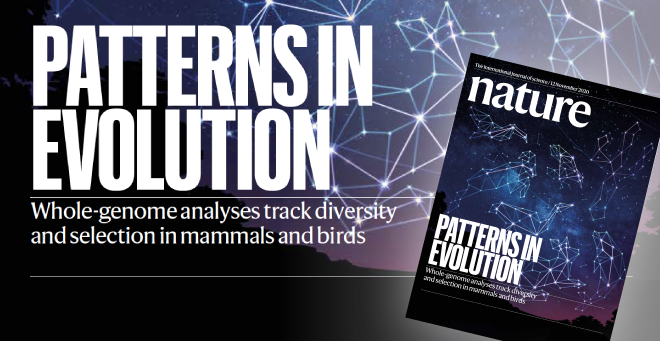
The Zoonomia Project, published in 13 studies in Science this week, is using comparative genomics to shed light on how certain species achieve extraordinary feats, and to better understand parts of the human genome and how they might influence health and disease.
“One of the biggest problems in genomics is that humans have a really big genome, and we don’t know what all of it does,” said Elinor Karlsson, PhD, associate professor of molecular medicine at UMass Chan Medical School and co-leader of the Zoonomia Project with Kerstin Lindblad-Toh, PhD, professor of comparative genomics at Uppsala University in Sweden. “This package of papers really shows the range of what you can do with this kind of data, and how much we can learn from studying the genomes of other mammals.”
Over the past 100 million years, mammals have adapted to nearly every environment on Earth. Scientists with the Zoonomia Project have been cataloging the diversity in mammalian genomes by comparing DNA sequences from 240 species that exist today, from the aardvark and the African savanna elephant to the yellow-spotted rock hyrax and the zebu.
Investigators identified regions of the genomes that are most unchanged (conserved) across mammalian species and millions of years of evolution—regions that are likely biologically important. They also found part of the genetic basis for uncommon mammalian traits such as the ability to hibernate or sniff out faint scents from miles away. And they pinpointed species that may be particularly susceptible to extinction, as well as genetic variants that are more likely to play causal roles in rare and common human diseases, according to Dr. Karlsson, who is also director of the vertebrate genomics group at the Broad Institute of MIT and Harvard.
The findings come from analyses of DNA samples collected by more than 50 institutions worldwide, including many from the San Diego Zoo, which provided genomes from species that are threatened or endangered.
For Karlsson, Dr. Lindblad-Toh and the researchers who have been sequencing mammalian genomes for Zoonomia or its precursor projects since 2005, these studies—and the breadth of questions they answer—are only a fraction of what is possible.
“We’re very enthusiastic about sequencing mammalian species,” said Lindblad-Toh, scientific director of vertebrate genomics at the Broad. “And we’re excited to see how we and other researchers can work with this data in new ways to understand both genome evolution and human disease.”
More than 150 people across seven time zones have contributed to the Zoonomia Project, which is the largest comparative mammalian genomics resource in the world.
Regulating Elements
In one study from researchers at UMass Chan, Morningside Graduate School of Biomedical Sciences PhD student Gregory Andrews and alum Kaili Fan, PhD’22, along with MD/PhD student Henry Pratt, utilized a variety of methods, including evolutionary conservation and epigenomic data, to identify conserved regulatory elements in the human genome.
Led by Zhiping Weng, PhD, the Li Weibo Chair in Biomedical Research, professor of biochemistry & molecular pharmacology and director of the Program in Bioinformatics & Integrative Biology, scientists showed that regulatory elements outside the protein coding areas of the genome are highly heritable, deeply conserved and are significantly enriched in genetic variants associated with complex, multi-factorial human traits, thus highlighting their importance in the functional interpretation of human genetic variation.
“Our study provides a comprehensive analysis of the evolutionary landscapes of millions of regulatory elements across placental mammals, allowing us to identify highly conserved regulatory elements,” said Dr. Weng. “This valuable catalog of elements is expected to facilitate future research on investigating the impact of human genetic variations on diseases and traits.”
The uniqueness of Balto
In another paper, Kathleen Morrill and Xue Li, PhD students in the Karlsson lab, investigated the genetic history of the renowned sled dog Balto, who delivered life-saving diphtheria serum to the children of Nome, Alaska, in 1925.
The team sequenced Balto's genome from DNA extracted from his taxidermized remains, which now reside in the Cleveland Museum of Natural History. They compared his DNA sequence to hundreds of other dogs and representatives of 239 other species of mammals and concluded that Balto (one of the original Siberian huskies) only shared part of his ancestry with modern Siberian huskies.
Unlike modern breed dogs, Balto was more genetically diverse and less inbred. He and his brethren likely carried genetic changes that helped them survive the harsh conditions of 1920s Alaska according to Karlsson and colleagues.
The authors used Balto’s DNA sequence to predict Balto’s physical appearance, including his size and coat color, and compare their predictions to historic records. This study underscores the importance of comparative genomics for interpreting paleogenomic data.
Exceptional traits
In another of the studies published today, co-first authors Matthew Christmas, PhD, a postdoctor researcher at Uppsala University, and Irene Kaplow, PhD, a postdoctoral researcher at Carnegie Mellon University, along with Karlsson, Lindblad-Toh and collaborators, found that at least 10 percent of the human genome is highly conserved across species, with many of these regions occurring outside of protein-coding genes. More than 4,500 elements are almost perfectly conserved across more than 98 percent of the species studied.
Most of the conserved regions—which have changed more slowly than random fluctuations in the genome—are involved in embryonic development and regulation of RNA expression. Regions that changed more frequently shaped an animal’s interaction with its environment, such as through immune responses or the development of its skin.
The researchers also pinpointed parts of the genome linked to a few exceptional traits in the mammalian world, such as extraordinary brain size, superior sense of smell and the ability to hibernate during the winter.
With an eye toward preserving biodiversity, the researchers found that mammals with fewer genetic changes at conserved sites in the genome were at greater risk for extinction.
Karlsson and Lindblad-Toh explained that even having just one reference genome per species could help scientists identify at-risk species, as less than 5 percent of all mammalian species have reference genomes, though more work is needed to develop these methods.



